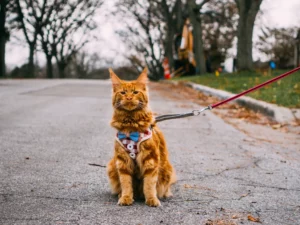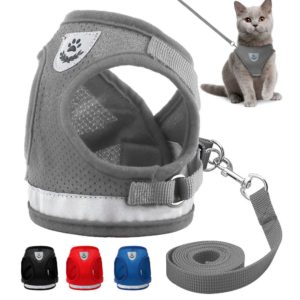Is it possible to walk cats on a leash? Some veterinarians believe that walking stimulates the mental activity of a pet and helps it stay in great shape. Others associate the street with great stress and a number of dangers to the animal’s health. Whether it is necessary to walk cats, what threats the “wild nature” poses and what to do if a pet asks to walk — read our article.

IS IT NECESSARY TO WALK A CAT ON THE STREET
Introverted cats have enough games in the walls of the apartment and communication with the owner. Such animals do not feel like prisoners, and it is enough for them to spend a couple of hours at the window to enjoy contact with the outside world. If the cat has never been outside and does not show interest in what is happening outside the house, you should not forcibly take her out for a walk — such a gesture will not appeal to the pet.
Inquisitive cats, who always strive to slip out the door, on the contrary, will enthusiastically accept an invitation for a walk. For them, familiarity with the street will benefit and satisfy the need for new experiences. But do not rush to get a harness: you need to prepare carefully for the first appearance so that the walk is comfortable and safe.
Please note that not all animals can be walked. Even if your pet is eager to go outside, check if he is not in the “risk group”.
Which animals are better to leave at home:
- Unvaccinated kittens aged 3-6 months. Babies have no immunity against diseases, and contact with the outside world can be deadly for them. To give a kitten a new experience, it is not necessary to go outside.
- Animals that have been vaccinated less than 2 weeks ago. Their body is still weakened, and immunity against diseases has not been formed;
- Timid animals whose behavior outside the house is unpredictable;
Pregnant and nursing cats, as well as cats during sexual desire. When a cat has offspring, she needs special care: give her a quiet and peaceful place where she will feel safe and pay attention to a balanced diet. - Pets who have undergone surgery or a serious illness;
- Elderly animals that have never been outside. Unfamiliar smells and sounds are stress, which can negatively affect their health.
The rest of the pets can be walked, but they should be accustomed to a harness and leash at home in advance. It is also necessary to take care of vaccination and treatment against fleas and ticks.
IS IT POSSIBLE TO LET THE CAT GO FOR A WALK ON ITS OWN
If you have a private house, independent travel can be a good analogue to walking on a leash. But you should take care of important nuances:
- Make sure that the walking area is securely fenced.
A tight fence and the absence of cracks will protect the cat from encroaching on unwanted territory and prevent other animals from entering the yard; - Make sure that there are no poisonous and toxic plants in the place of walking that the cat can eat;
- Treat your pet with flea and tick repellent with prolonged action;
- You should be together with the cat during the walk. The animal will feel more comfortable and you will be able to control its movements.
Walking in the “wild” has certain risks. A pet can get injured in a fight with other animals, get hit by a car or get lost. There is also a high probability of infection with infectious diseases, for example, feline leukemia or the immunodeficiency virus. Therefore, we advise you not to take risks and walk the cat only under strict supervision.
RULES FOR WALKING A CAT ON A LEASH
Before introducing a pet to a new world, it is necessary to prepare both the owner and the animal. There are several rules that will make the walk safe and comfortable:
- Take care of the health of a four-legged friend;
- Buy equipment.
To walk a cat, you will need a harness and a leash.
A harness is a ribbon covering part of the animal’s back and chest. When choosing a harness, you should rely on the size, age and texture of the pet’s fur. The accessory should sit tightly on the trunk so that the cat could not get out of it on its own. Also, it should not restrict movement, squeeze the body and cause discomfort.
When choosing a leash, pay attention to its length: the leash should allow the animal to move within a radius of 2-2.5 m.

Introduce the cat to new accessories
It is not necessary to forcibly put on a harness: an accessory should be associated with positive emotions in a cat. Let the animal sniff the harness, touch and play with it. Every time a pet shows interest in an accessory, encourage it with a treat or a caress.
If you see that the cat got acquainted with the harness, try to put it on the animal. But do not insist: the cat will agree to the fitting when it is ready.
Take your first test drive at home. Let the pet walk around the house in full uniform and get used to the feeling of a harness on his body. After a successful “internship”, you can move on to walking on the street.
Choose the area before walking the cat
The area for a walk should be quiet and calm. A place away from cars and dog walking is ideal. It is also necessary to make sure that no poisonous and toxic plants grow in the place of the walk.
Provide your pet with a sense of security
You should take the animal outside in a carrier. At home, put on a harness beforehand, as in a stressful situation the cat may begin to resist.
Put the carrier on the ground and open the door. Do not force the pet to come out. He will do it himself when he gets used to new sounds and smells.
Don’t pull on the leash
Walking with cats is not the same as walking with dogs. The cat will not follow the owner, but will choose the direction that she is interested in. If the cat does not want to go, do not pull on the leash: force will not make the walk pleasant.
Monitor the condition of the animal
If the cat tries to hide, shows anxiety or aggression, it’s time to go home. It is better to gradually increase the walking time: start with 10 minutes and increase depending on the condition of the pet.
Dangers when walking a cat
There are enough dangers for animals on the street, and you may not even guess about some of them:
Ticks and fleas
Even stay-at-home cats are not immune from ticks and fleas. On the street, the risk of encountering blood-sucking insects increases significantly, so it is necessary to treat the animal’s fur with special means. Drops, sprays or collars — consult with a veterinarian, and he will choose the appropriate option.
Cars, people and other animals
Cats that walk on their own can get hit by a car or get hurt by another animal. If the cat is thoroughbred, it can simply be stolen. Walking with the owner will protect the pet from such risks.
Diseases
In places where stray animals congregate, there is a high risk of contracting an infectious disease. If your cat does not have vaccinations, refrain from any walks in order to preserve the health of a furry friend.
Wild rats and mice
Rats and mice are also carriers of infectious diseases. Hunting a sick rodent can lead to a fatal outcome: if a cat becomes infected with rabies, it will not be possible to save it.
Poison and worms
Any food on the street is dangerous for a pet: it may contain poison or worm eggs. If you walk with a cat on a leash, do not let her pick up food and regularly carry out deworming.
WHAT TO DO IF THE CAT ASKS TO GO OUTSIDE
The thirst for walking can have many reasons. Non-castrated pets may rush outside to find a partner. Active cats, whose need for hunting is not satisfied within the walls of the house, will look for an opportunity to go in search of prey outside the home. If you do not plan to walk your pet, try to make his life in the apartment interesting and close to the “wild nature”:
- Make sure that the animal has enough toys. If a cat has one ball at its disposal, do not be surprised that she is eager to walk;
Get a vertical gaming complex or hang shelves on the wall at different heights so that the cat splashes out energy and can keep herself in good shape; - Arrange places to rest on the cabinets so that the pet can watch what is happening from the shelter;
- Make sure that the furry friend has a balanced diet. Do not skimp on nutrition: lack of nutrients can lead to health problems;
- Let the cat out for a walk on the balcony. But keep in mind that it must be of a closed type, with grids on the windows so that the animal does not fall;
- Play with your pet more often to satisfy his need for hunting;
- Get a partner for your pet. If the cat is active and sociable, she will be glad to have a companion. But do not think that the animals will get along right away: it will take time and your participation for them to become friends.
And one of the main tips: listen to a four-legged friend, he will tell you what he lacks in the walls of the apartment. Try to arrange the home space so that it meets all the needs of the animal. Then the pet’s life will become brighter, and his interest in the street will be less.
Whether to walk the cat or not is up to the owner. Independent walks are dangerous for a cat, and walking on a leash requires financial investments and time. If you think that the pet needs to walk, take a responsible approach to preparation: the main condition for walking should be safety.
